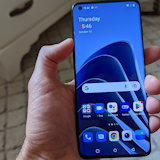 The HTC One S is the second smartphone down the new HTC One line of phones comprise of the One X, One S and One V in descending order of hardware specs. The One S is a sleek device aimed at providing a solid, modern Android experience without charging premium rates or relying on OS updates. We grabbed a hold of one to see just how successfully HTC managed to deliver this reliable yet affordable experience to its users with our HTC One S review.
The HTC One S is the second smartphone down the new HTC One line of phones comprise of the One X, One S and One V in descending order of hardware specs. The One S is a sleek device aimed at providing a solid, modern Android experience without charging premium rates or relying on OS updates. We grabbed a hold of one to see just how successfully HTC managed to deliver this reliable yet affordable experience to its users with our HTC One S review.
Physical Design of the HTC One S
We’ve often commented on the fantastic build quality and aesthetic appeal that HTC brings to its devices and the HTC One S is no different. The aluminium casing is somewhat unique, in that it starts out as regular old Air Craft 6000 Series aluminium and is then subjected to around 10 thousand volts of energy. The process triggers a chemical reaction at the microscopic level, creating a ceramic-like feel on the surface of the device. The end result is a case that is 5x stronger than other aluminium treatments and 3x stronger than some stainless steels. You're left with a phone that almost oozes quality from the moment you pick it up. It’s durable, looks fantastic and feels really unique to the touch.
The design itself is also impressive. A stylish, sleek design with tasteful curves is complemented by the edge-to-edge glass on the sides of the handset. There’s even a sort-of garnish around the back of the device in the form of a colored metallic ring surrounding the camera lens. All of this coupled with the reassuring weight, relatively easy & comfortable grip and lack of protruding edges to stick in to the side of your head when on a call we’d have to say that this is hands-down one of our favorite phones in terms of physical design.
The right-side volume rocker at first appears to protrude an alarming amount, bringing us to expect accidental volume-changes while carried in the pocket. Fortunately we experienced no such problems and our melodies flowed forth with uninterrupted regularity. The top-side power/lock button may prove a bit tricky for those with smaller hands, but once again we found it to be satisfactory.
We will quickly mention that the battery is non-removable, as the One S is continuing HTC’s new theme of unibody designs. However, most users don’t end up buying spare batteries for those rare occasions where they run out of charge and need to switch out. As such we don’t see this being too much of an issue. The SIM can still be easily swapped in and out via a small plastic panel at the top of the handset. There is no MicroSD slot for expandable memory.
 Display and UI
Display and UI
The 4.3 inch 540x960 (qHD) AMOLED display of the HTC One S is pretty good. Of course after using something like the Samsung Galaxy S III or HTC One X with their huge 720p displays the qHD offerings of the One S are obviously inferior. We actually found that we immediately noticed the pixilation, despite the fact that just a handful of months ago we would have been wowed by the 540x960 resolution of the One S.
What we mean is that the average phone shopper definitely won’t find the One S’ screen overly pixelated or lacking in clarity or definition. It offers sharp edges to its shapes, vibrant colors, clear whites and stark blacks. Overall it’s a very good screen; it’s just one that’s being outshone by the premium offerings of the higher end of the market right now. But that’s to be expected, as the One S was never designed to compete in the big leagues. For its price-range we were more than pleased with the overall experience.
Running on Android 4.0.3 Ice Cream Sandwich (ICS) HTC’s Sense 4.0 user interface (UI) was as lovely and smooth as ever. One small issue we had that other manufacturers have addressed in ICS is that the Home Screen side-scrolling was linear, rather than circular. What we mean by that is that when one swiped to the furthest home screen to the right one couldn’t then continue to swipe to the right and jump to the furthest left screen and vice versa. It’s a small inconvenience but we’ve found that it’s something which can really help add to the overall feeling of smoothness with a UI.
The same held true in the Applications menu. Once again a minor inconvenience that was more puzzling than frustrating, as we were left scratching our heads as to why HTC didn’t include it.
Overall we found the UI to be intuitive, smooth and fast. The HTC One S handled ICS with much better efficiency than other devices with similar specs that were released with Android 2.3 Gingerbread and then received ICS as a later update, such as the Samsung Galaxy S II. Where an ICS updated GS2 can lag significantly at random intervals the HTC One S offered no such frustrating pauses, except for occasionally when loading in-game ads for Zynga apps. Strangely, we found the problem to be limited to that very specific area of use.
As usual, the Lock screen was great. HTC Android devices have the option for users to jump straight to Phone, Messages, Email or Camera right from the Lock screen. Each icon displays how many (if any) outstanding notifications there are specifically for themselves which allows users to glean a surprising amount of information at a glance. This kind of thing really makes checking your phone for missed notifications so much faster and easier, as a user often doesn’t have to even go past the Lock screen.
Alternatively, for users who do not utilize security passwords, the drop-down notifications tray is accessible straight from the Lock screen in ICS. This is a fantastic edition that really adds something to Lock screen functionality.
All up there wasn’t anything particularly new with the general UI of the One S, but it was a fluid and enjoyable experience nonetheless.
 Camera & Battery Power
Camera & Battery Power
The 8MP camera on the One S is fairly good, but not really anything more than that. It seemed to boast only slight improvement in terms of autofocus and low-light shots over its predecessors like the HTC Sensation and Sensation XL and photos in well-lit situations turned out relatively similar, despite HTC’s new light sensor technologies.
Video capture didn’t seem to have improved at all. It was still passable in direct sunlight, or well-lit areas. In dimmer situations, however, it was still a little underwhelming. It was no worse than previous iterations of HTC phones, or than other Android devices with similar specs but it was still a bit disappointing all the same.
There was a cool bit of functionality that has been added, namely that users can now take photos while filming. During video capture the shutter button stays on-screen and can be tapped whenever. Captured photos will be displayed in the bottom corner of the screen and can be viewed when tapped. It’s not an amazingly handy addition, but ultimately it’s a good addition.
HTC has long struggled with battery issues on its smartphones. While recently we’ve begun to see vast improvements on HTC devices, the One S does still have questionable battery life at times. Generally everyday use was fine and we would make it right through till late in the night before needing a recharge. However, on days where we were a bit more 3G-intensive the One S often died by around 7pm. We pushed that figure back a little by deleting some of the more power-hungry home screen widgets, but the One S still didn’t quite have the same longevity as we found with HTC’s current flagship when we did our HTC One X review a while back.
At the end of the day the One S was still leaps and bounds ahead of what HTC was offering around a year and a half, or even a year ago in terms of power efficiency. Most users shouldn’t find themselves searching for a charger before bed time, but those who like to spend a lot of time using the web should be cautious.
 Music and Media on the HTC One S
Music and Media on the HTC One S
The One S handled music and video pretty well. The music player was a fairly standard Sense UI experience, meaning it was smooth, intuitive and glitch-free. Aesthetically it was pleasing to the eye and, as always, we loved the lock-screen functionality. While it’s true that most devices have the option to skip currently playing tracks from the lock screen these days no one else seems to do it with as much style as HTC. The central, flappable graphic really does just look better than alternative options and the ability to jump straight to the music player while it’s operating just makes things easy.
Video playback was also fairly good. As we mentioned before the 540x960 (qHD) resolution of the One S isn’t as impressive as some of the 720p HD screens out there these days, but it still held its own. For a device in this price range a qHD display is actually quite good, as many other smartphones offer only 480x800.
Colors on the AMOLED screen came out vibrant and bright. Shapes were well defined and whites came out crisp. Blacks weren’t as dark as on something like a Nokia ClearBlack display, it definitely wasn’t bad enough to detract from the experience. If this was a premium device we might have been a bit disappointed with the lower resolution. But for a smartphone in this price range the One S was nothing short of impressive when it came to video playback.
 Keyboard and Browsing
Keyboard and Browsing
The keyboard was fast and responsive. Most modern smartphones don’t struggle with fast typists and the One S was no exception. We didn’t once find ourselves having to slow down and wait for the One S to catch back up.
Size-wise it was very easy to type in landscape. The 4.3 inch screen had more than enough room to accommodate our larger fingers. In portrait mode we did occasionally struggle, but that felt more like user error than the fault of the handset itself.
Browsing was fast, clear and hassle-free. On WiFi the One S actually out-performed the Galaxy S3 on more than a few occasions, loading pages just slightly faster than the current Android throne holder.
4.3 inches isn’t actually that big for a screen these days, but it’s still more than adequate for easy browsing. Colors came out vibrantly due to the AMOLED technology and text rendering was crisp and easy to read.
Pinch-to-zoom was fast and seldom caused lag. Overall it was an impressive browsing experience that should keep even the most avid of users happy.
 The WhistleOut Opinion
The WhistleOut Opinion
The HTC One S might not be the best phone out on the market right now, but it’s an impressive piece of hardware. In its price range we can’t think of any current phones that we’d recommend more highly. The dual-core 1.5GHz processor is powerful enough to handle just about anything we could throw at it and the 1GB of RAM ensured that things ran smoothly.
Running on ICS out of the box is a big advantage for the One S over other smartphones with the same hardware specs, as many of those phones are remnants from last year’s pickings. Running ICS by default, rather than relying on an update, means that the One S has been designed specifically with Android 4.0 in mind, allowing for a smoother overall experience.
We were a bit disappointed with the camera, but not so much that we would call it a deal-breaker. Music was good, video was more than good and browsing was great. The 4.3 inch display offers ample screen real-estate without being too intimidating like larger devices can be to some.
As far as build-quality goes there really are very few phones around right now that can compete with the One S in both feel and style. It’s a uniquely designed device that really does put other manufacturers like Samsung and Motorola to shame.
Anyone who is looking for a mid-to-high end device should absolutely take a look at the HTC One S while they’re comparing smartphones.



Related Articles
Find Better Phones and Plans
Hundreds of cell phone plans unpacked. All the facts. No surprises.



































